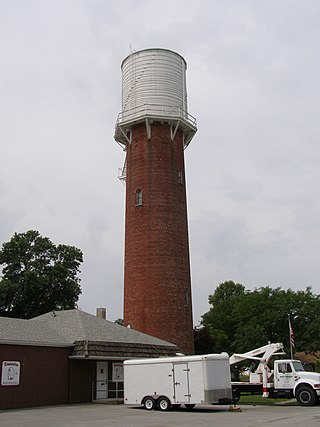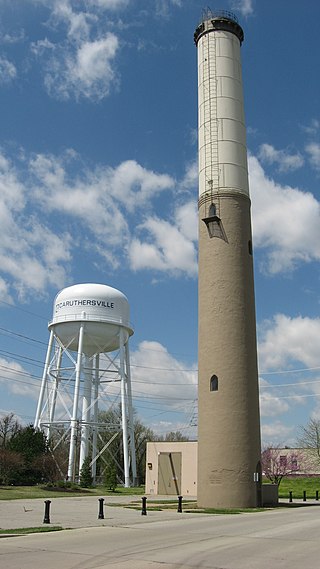
East Brother Island Lighthouse is a lighthouse located on East Brother Island in San Rafael Bay, near the tip of Point San Pablo in Richmond, California. It marks the entrance to San Pablo Bay from San Francisco Bay.

The Ypsilanti Water Tower is a historic water tower in Ypsilanti, Michigan, United States.

Duncan Manor is a historic house located in rural McLean County, Illinois, near Towanda. The house was built circa 1866 for William R. Duncan, a livestock breeder, who was well respected for his short-horned cattle.

The Beloit water tower is a historic octagonal limestone water tower completed in 1889 in Beloit, Wisconsin.

The Judge John C. Flanagan Residence is a historic house in Peoria, Illinois, United States. It was added to the National Register of Historic Places in 1975 and is currently operated as a museum by the Peoria Historical Society.

Peoria Mineral Springs is 14,500-year-old natural spring in the city of Peoria, Illinois, United States. The site, also known as Spring Hill, is located on a hillside on the historic West Bluff between Martin Luther King Jr. Drive and Moss Avenue.

The Pettengill–Morron House, or simply Morron House, is a historic mansion located in the city of Peoria, Illinois, United States. This Second Empire style home is located in the local historic Moss-High District. The property was added to the National Register of Historic Places and is a City of Peoria Local Historic Landmark. It currently operates as a museum by the Peoria Historical Society.

The Lena Water Tower is a water tower located in the village of Lena, Illinois, United States. It was built in 1896 following two decades of problems with structure fires in the village. The current water tower is the result of a second attempt after the first structure proved to be unstable. The tower stands 122.5 feet (37.3 m) tall and is built of limestone and red brick. The current stainless steel water tank holds 50,000 gallons and replaced the original wooden tank in 1984. The site has two other structures, an old power plant building and a 100,000 US gallon reservoir. The Lena Electric Plant Building was constructed in 1905 and the reservoir completed in 1907. The Lena Water Tower was listed on the U.S. National Register of Historic Places in 1997; the reservoir was included as a contributing property to the listing.

The Campana Factory is a historic building in Batavia, Illinois. It was built in 1936 to serve as a factory for The Campana Company, which produced Italian Balm, the most popular hand lotion in the United States during The Great Depression. The Streamline Moderne and Bauhaus building features many innovative technologies, such as air conditioning. It was added to the National Register of Historic Places in 1979.

The Ransom Water Tower is a former water tower in the LaSalle County, Illinois, village of Ransom. It was added to the U.S. National Register of Historic Places in 1990.

The Clock Tower in Rome, Georgia is one of the oldest landmarks in the city. The Clock Tower is located at the summit of Clock Tower Hill one of the Seven Hills of Rome.

The Water Tower was built in 1897 by Challenge Wind and Feed mill Company of Batavia, Illinois. This is a rare wooden tank atop a brick tower type of water tower. Built on a limestone foundation, it is 140 feet (43 m) tall and about 20 feet (6.1 m) in diameter. The brick walls are 2 feet (0.61 m) thick.

The Benson Water Tower was a water tower located on Clayton Street in Benson, Illinois. The tower was built in 1891, in response to several serious fires in Benson; it supplied the village with water until 1985. The tall brick tower had a large wooden water tank on top. The tower was added to the National Register of Historic Places in 1987. It has since been demolished, and was delisted in 2020.

The Kalamazoo State Hospital Water Tower is located in Kalamazoo, Michigan. It was built in 1895 and was added to the National Register of Historic Places on March 16, 1972. It is located on the grounds of the Kalamazoo Regional Psychiatric Hospital.

The Brooks Catsup Bottle water tower, trademarked "The World's Largest Catsup Bottle", is a water tower south of Collinsville, Illinois. It is claimed to be the largest catsup bottle in the world at 70 feet tall on a 100 foot stand with a volume of 100,000 gallons, which could theoretically hold 640,000 bottles of catsup. As a prime example of mid-20th-century novelty architecture, it is listed on the National Register of Historic Places. The tower is most notable in its capacity as a regional landmark and as a roadside attraction.

The Fort Sheridan Water Tower is a water tower in Fort Sheridan, Illinois.

Grand Mound Town Hall and Waterworks Historic District, also known as Hose house, pump house, is a historic district located in Grand Mound, Iowa, United States. It was listed on the National Register of Historic Places in 2001. The district is composed of two buildings and the town's water tower.

The West Water Tower and Ground Storage Tank are a historic water tower and storage tank located at 310 11th Avenue in Orion, Illinois. The tower and tank were built in 1928 as part of the village's new water system, which had been approved the previous year. The water system was introduced both as a response to several fires which had plagued the village and as an effort to bring modern technology and progress, among other civic concerns. The water tower consists of a steel tank with a hemispherical bottom supported by a steel trestle; the structure is 136.5 feet (41.6 m) tall. The ground storage tank, located at the base of the tower, is made of redwood and holds 30,000 US gallons of water.

Caruthersville Water Tower, also known as The Lighthouse, is a historic water tower located at Caruthersville, Pemiscot County, Missouri. It was built in 1903, and is an elevated stand-pipe design stuccoed brick water tower with Gothic style embellishments. The tower supports a steel-plated 40,000 gallon tank. The tower measures 115 feet high, 13 feet in diameter, and 41 feet in circumference.

The Highland Park Water Tower is a historic water tower on the west side of Green Bay Road in Highland Park, Illinois. Built in 1929–30, the brick water tower is 125 feet (38 m) tall, making it the tallest structure in Highland Park. The tower is Highland Park's third water tower and serves as a visual and symbolic landmark for the city. Its design features tall brick arches on its eight sides and a classical pediment above its entrance. The tower's water tank is capable of holding 500,000 U.S. gallons (1,900,000 L).




















